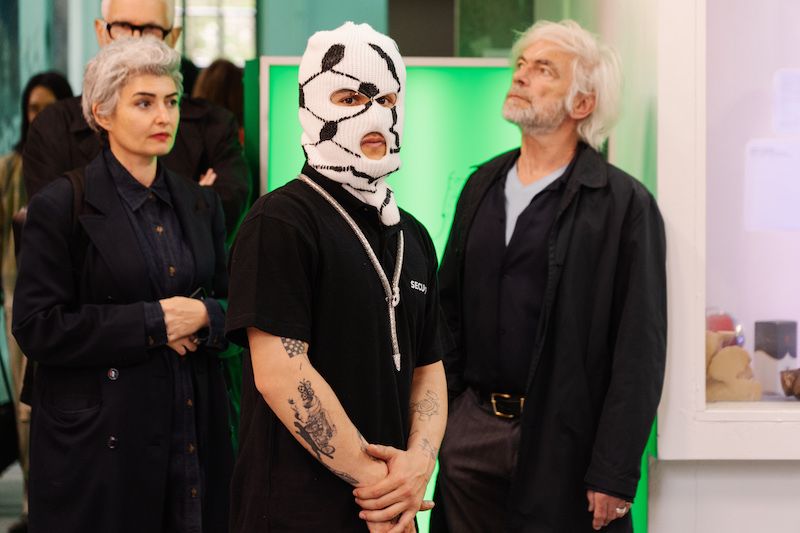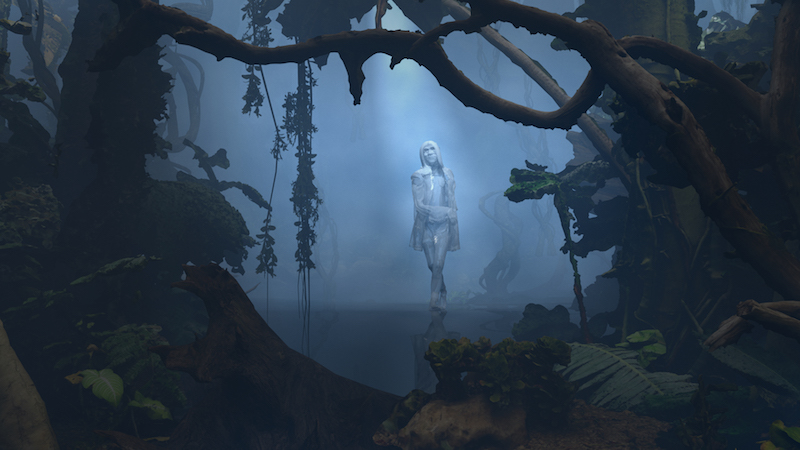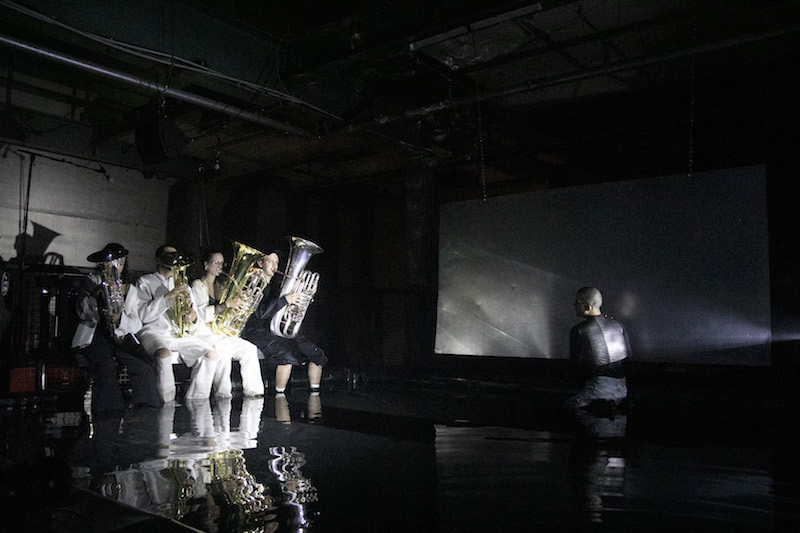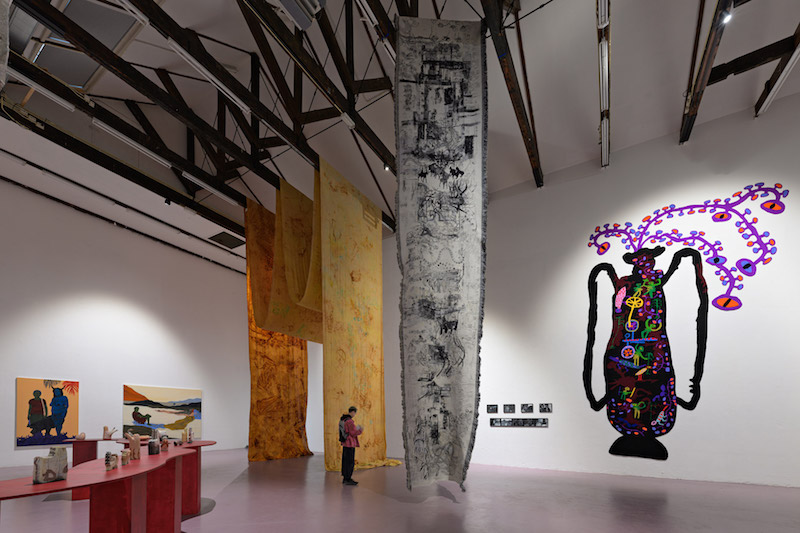by Alison Hugill // May 30, 2024
Amsterdam Art Week kicked off yesterday with a full program of exhibitions and events in art institutions, galleries, private collections, residencies and project spaces across the city. Director Martina Halsema introduced us to the organization’s vision and history, beginning 12 years ago and born out of the Rijksakademie’s established Open Studio event, which takes place annually and offers an introduction to the works of 50 artists from around the world. Below, we’ve compiled some program highlights to check out during Art Week and beyond.

Rijksakademie
Open Studios: May 30-June 2, 2024
rijksakademie.nl
Sarphatistraat 470, 1018 GW Amsterdam, click here for map
Artists undertaking two-year residencies in the historic ateliers of the Rijksakademie open their doors to the public during Amsterdam Art Week, with a diverse presentation—from fully-formed exhibitions within their white-walled spaces to works-in-progress or sneak peeks into the studio process itself. Among the highlights from this year’s offerings were Nigerian artist Eniwaye Oluwaseyi’s vibrant paintings, which combine personal memories and representations of family and friends with haunting allusions to deeper psychological dimensions, such as the recurrent motif of a skeleton in the works on display.
Nearby, Palestinian artist Noor Abed screens her new film ‘A Night We Held Between’ (2024), a particularly moving piece to encounter this week, as the latest major offensive in Rafah, killing displaced families sheltering in tents, has rocked the global movement for Palestine. Set in ancient sites across Palestine—caves, carved holes, underground passages and wild valleys—the landscape depicted in the film points to what has been lost, but is infinitely restored through a communal, ritual-like exploration of land and culture, centered around a song that the artist sourced from the sonic archive of the Popular Art Center Palestine.
On the ground floor, Susanne Khalil Yusef presents one of her signature colourful mixed-media installations but again draws attention to the current situation in Gaza, with a performative element featuring a person in a balaclava—marked with the pattern of a traditional keffiyeh—who periodically tags the studio walls with a slogan of the movement—like “End the Siege on Gaza Now!”—in both English and Arabic. Khalil Yusef’s practice, while joyful and expressive, underscores these immense feelings of distress in relationship to questions of homeland and displacement that are not new to her work, but gain new dimensions in light of recent escalations in violence.
Around the corner, Shaun Motsi’s work—a series of oil paintings on linen, which look like a zoom-in on a Rittersport hazelnut chocolate bar—point to a slew of possible colonial references and associations that the artist deliberately leaves opaque, resisting the urge to consume the “other” through these forms of understanding. Many artists taking part in the Open Studios this year have used the occasion to vocalize their support for Palestine, whether in the content of their work or through the choice to display a call to “stop the genocide” on the Rijksakademie website, in lieu of an image of their work (as more than 20 participating artists have done). Compared to commercial presentations in the city, there is an overwhelming sense that business as usual has been disrupted here.

Amsterdam Art Week 2023 // Photo by Almicheal Fraay
AKINCI
Margit Lukács & Persijn Broersen: ‘I Wan’na Be Like You’
Exhibition: May 30-July 13, 2024
akinci.nl
Lijnbaansgracht 317, 1017 WZ Amsterdam, click here for map
Amsterdam mainstay AKINCI—established in 1988 and offering an exhibition program that focuses on socio-political, ecological and gender questions—presents the work of artist duo Margit Lukács & Persijn Broersen for this year’s Amsterdam Art Week. Like many of the artists on view in the city this week, the pair were once residents at the Rijksakademie, which quickly reveals itself as a source of up-and-coming talent to be picked up for representation in local commercial spaces.
For this occasion, Lukács and Broersen are screening their new film ‘I Wan’na Be Like You,’ which takes as its subject matter the western image of the “jungle.” The duo visited dozens of botanical gardens across Europe, taking thousands of photos which they digitally assembled through 3D modelling and moulding to create the haunting landscape in the film. In it, an avatar of a ghost performs a choreography that reveals the dark sides of treating wilderness as “unexplored” land, ripe for colonial takeover.
The title of the film, as well as the exhibition, is drawn from the song of the same name in Disney’s 1967 ‘Jungle Book’ movie. The film, ‘I Wan’na Be Like You,’ features a specially composed piece of music based on that song, but reinterpreted as both a tribute to the New Orleans jazz tradition and an indictment of the underlying racism in the Disney original. Following the ghost’s enchanting choreography in the ruinous landscape of the botanical gardens, a polyphonic chorus enters the scene, voiced by two members of the choir Black Harmony (Jamal Bijnoe and Orlando Ceder) singing ‘Na Mi’ (Sranang for ‘I am’)—a proud celebration of the history of their ancestors.

Margit Lukács & Persijn Broersen: ‘I Wan’na Be Like You,’ 2024, video still // Courtesy of the artists and AKINCI
De Thomas
Billy Bultheel: ‘The Thief’s Journal: Songs of Decreation’
Performance: Thurs. May 30 and Fri. May 31, 8:30pm
dethomas.nl
Pr. Irenestraat 36, 1077 WX Amsterdam, click here for map
Following Billy Bultheel‘s performance of ‘A Thief’s Journey’ at Kraftwerk during Berlin Art Week last year, the artist returns with his latest interpretation of the piece, revisited in the Brutalist architecture of the De Thomas church in Amsterdam. Working at the intersection of music, performance and installation, Bultheel composes all-encompassing works that incorporate music, noise, electronics and metal with influences from Medieval and Renaissance polyphonic traditions.
The architecture of the space is always at play in Bultheel’s work, as he considers the spatial and social aspects of his choreographies, beyond the mere acoustics of the buildings his works inhabit. For this performance, nine musicians come together to activate the traditionally sacred or religious space, infusing it with elements from popular culture. ‘The Thief’s Journal: Songs of Decreation’ takes its name from the semi-fictional autobiography of French novelist, playwright, poet and activist Jean Genet and pays homage to the writer’s contrasts of high and low culture, bringing together “the religious with the cathartic, the sacral with the industrial and the communal with the ritualistic.”

Billy Bultheel: ‘The Thief’s Journal,’ 2023, documentation // Photo by Spyros Rennt
W139
Group Show: ‘Outside the Soup’
Exhibition: Apr. 26-July 21, 2024
w139.nl
Warmoesstraat 139, 1012 JB Amsterdam, click here for map
In addition to commercial galleries, several project spaces take part in Amsterdam Art Week’s official program, including the artist-run space W139. Initiated as a squat in 1979, the space is one of the few remaining experimental artistic spaces that fosters a radical sense of community amongst its collective. Most of the art spaces in this part of the city center have closed due to increasingly high rent, but W139 remains despite having recently had its structural funding revoked.
The current exhibition at W139, which opened at the end of last month, points to many of the positive aspects that these kinds of spaces provide: working side-by-side on mostly site-specific pieces, the artists in this group show have prioritized the experimental processes of care, friendship, collaboration and exchange within the so-called “artistic ecosystem” they are hoping to maintain. In ‘Outside the Soup,’ we find examples of some impressive works by local as well as international artists, initiated and curated by artists Afra Eisma and Hend Samir. Eisma is also a former Rijksakademie artist-in-residence and currently has a separate solo show at No Man’s Art Gallery, opening during Art Week.
W139 is an imposing space with very high ceilings, and many of the artists involved in the show have taken the challenge to make works in a larger scale. Eisma’s own giant tapestry, ‘celestial dream,’ sits alongside Dagmar Bosma’s more than 40m-long, draped textile work, ‘Scrap Metal Dream Boat (Beam Me Up!),’ which is imprinted with scraps of iron and copper from harbors and wastelands, transferred onto the fabric using rust-dyeing techniques. In the middle of the long corridor, Esraa Elfeky has brought to life an enormous and difficult-to-place creature, suggestive of a prehistoric, alien or extinct being.
At the entrance to the exhibition, an interactive game-work by Afra Shafiq, entitled ‘The Bride Who Could Not Stop Crying’ forms part of the artist’s larger research project into Slavic women’s embroideries, in this case exploring the idea of the wedding day as a day of mourning. Opposite the work, a denim hammock by Karin Iturralde Nurnberg invites visitors for a rest, but—as in other works and exhibitions presented during this year’s Art Week—the playfulness of its form quickly gives way to deeper considerations, political questions and dreams for a radically different future.

‘Outside the Soup,’ 2024, installation view at W139 // Photo by Pieter Kers | Beeld.NU






















